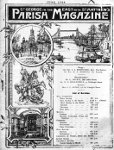 A decade of parish life: from the magazine, 1923-34
A decade of parish life: from the magazine, 1923-34
(4) Bicentenary 1929, and parish musical life
BICENTENARY
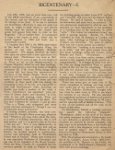 Plans
for the 200th anniversary of St George's in 1929 had been in the making
for some time. (Right is an article from six years before.) In the event, the parish found that it had to find £3000
for repairs to the roof, so fundraising featured prominently - more
details here. The fête was held on the Thursday and Saturday of the
weekend (with electric lighting in the gardens to enable stalls to stay
open later), leaving Friday free for the special service.
Plans
for the 200th anniversary of St George's in 1929 had been in the making
for some time. (Right is an article from six years before.) In the event, the parish found that it had to find £3000
for repairs to the roof, so fundraising featured prominently - more
details here. The fête was held on the Thursday and Saturday of the
weekend (with electric lighting in the gardens to enable stalls to stay
open later), leaving Friday free for the special service.
 Bishop Joscelyne, who preached on the Friday evening, had been a curate in the
parish in the 1890s. He was a substitute for the Archdeacon of London, who was unwell.
Bishop Joscelyne, who preached on the Friday evening, had been a curate in the
parish in the 1890s. He was a substitute for the Archdeacon of London, who was unwell.
On
the Monday, a special musical service was held, with the Dean of
Windsor preaching, and Sir Henry Walford Davies speaking afterwards on
church music, with illustrations by members of the choir of St George's
Chapel Windsor, where he had become director of music in 1927.
The
Rector has worked with Walford Davies for some years, on the People's
Palace Musical Festival (see below) and on various national musical
committees. He had been organist at the Temple Church until 1917 (in
later years, the Old Templars Choir were frequent visitors to the
parish) before becoming Professor of Music in the University of Wales,
and Gresham Professor of Music in London. However, at the time of his
first visit to the parish in 1925 (to give an organ recital after the
service) the Rector wrote that people in East London probably know him
better as a great teacher of music over "The Wireless". He speaks to
thousands of children and others every Tuesday at the present time.
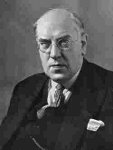 After
Walford Davies' bicentenary visit, the Rector wrote that, while the
Stepney Orpheus Choir's singing of Bach on first evening was
noteworthy,The visit of the choir of St George's Windsor, was a
much rarer thing: indeed, I think that no parish church has ever had
the privilege we had...
After
Walford Davies' bicentenary visit, the Rector wrote that, while the
Stepney Orpheus Choir's singing of Bach on first evening was
noteworthy,The visit of the choir of St George's Windsor, was a
much rarer thing: indeed, I think that no parish church has ever had
the privilege we had...
(Walford
Davies [pictured] was invited back the following year; he had hoped to bring choir
again, but cricket matches were taking up the boys' free days so
instead he brought the gentlemen of the choir, and spoke on 'Church
Melody', declaring that Christian song should express the Christian
temper and be marked by 'restrained exuberance'.
CHOIRS
As
a keen musician, the Rector encouraged the development of choirs in the
parish. As well as the church choir, which sang twice on Sundays (in
1926 he appealed for more tenors and basses), several of the
organisations had their own choir. The Stepney Orpheus Choir, which the
Rector had founded in 1908 and conducted ever since, now held
rehearsals at St George's, and performed regularly here; it was, he
said, well known and useful, singing at big church meetings around
London in aid of various church funds. They sang many carol services.
He wished more St George's people would join it; and noted after their
December concert in 1927 that it attracted a good number, though not
many were our own people.
Not
content with all of this, Beresford formed a parish male voice choir in
March 1928 - it rehearsed at 9pm on Friday in the Rectory (with a
weekly sub of 1d. for music), and in February 1930 a Choral Society,
bringing together members of the Girls' Club with the male voice choir.
The men rehearsed from 9pm to 9.30pm and the full choir until 10.30pm -
it was unfortunate, he said, it this was so late, but it clashed with
other fixtures. By September 1931 they were short of altos and basses,
but a few months later performed Mendelssohn's 'Hear my prayer' and
other music.
MUSICAL FESTIVAL
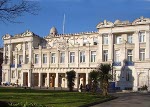

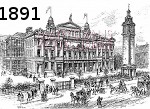 Every
May a musical festival, lasting several days, was held at the People's
Palace in Stepney [pictured here in a
drawing after the opening in 1887, in an early 20th century photograph
and after the 1931 rebuild following a fire; it is now part of Queen
Mary College], with choir competitions and a festival concert,
usually conducted by Sir Walford Davies. The Rector was one of the
organisers, and several choirs from the parish competed. They generally
won prizes in their various sections: the choirboys came second in 1926
and 1927 and first in 1930, the Girl's Club were third in 1927 and 1929
and second in 1932, the Guides won the Challenge Cup in 1927, 1928 and
1929 and took a first prize in 1930, and
second in 1932; the Scouts took first prize in 1928 and 1930; the
Mothers' Union took second prize in 1928, 1929 and 1930, and first in
1932; the Male Voice choir had a 'promising first appearance' in 1928,
first prizes in 1929 and 1930 and a certificate of merit in 1932, and
the new Choral Society came first in 1930 and 1932. But the Rector's
Stepney Orpheus Choir (which numbers some of our people amongst its
members) regularly walked away with the most prizes, winning the madrigal class,
singing at sight, vocal quartets and vocal trios in 1927, three firsts
and several seconds in 1928, firsts in all principal choral classes in
1929 and five firsts in 1930.
Every
May a musical festival, lasting several days, was held at the People's
Palace in Stepney [pictured here in a
drawing after the opening in 1887, in an early 20th century photograph
and after the 1931 rebuild following a fire; it is now part of Queen
Mary College], with choir competitions and a festival concert,
usually conducted by Sir Walford Davies. The Rector was one of the
organisers, and several choirs from the parish competed. They generally
won prizes in their various sections: the choirboys came second in 1926
and 1927 and first in 1930, the Girl's Club were third in 1927 and 1929
and second in 1932, the Guides won the Challenge Cup in 1927, 1928 and
1929 and took a first prize in 1930, and
second in 1932; the Scouts took first prize in 1928 and 1930; the
Mothers' Union took second prize in 1928, 1929 and 1930, and first in
1932; the Male Voice choir had a 'promising first appearance' in 1928,
first prizes in 1929 and 1930 and a certificate of merit in 1932, and
the new Choral Society came first in 1930 and 1932. But the Rector's
Stepney Orpheus Choir (which numbers some of our people amongst its
members) regularly walked away with the most prizes, winning the madrigal class,
singing at sight, vocal quartets and vocal trios in 1927, three firsts
and several seconds in 1928, firsts in all principal choral classes in
1929 and five firsts in 1930.
In
1928 the Duchess of York presented the prizes, and the Scouts were part
of the guard of honour. The following year the Rector encouraged people
to attend, even though the event would lack the glamour of a royal
presence ... those who have not had the opportunity of listening to choir
competitions do not know how interesting and exciting it is. Admission
is only 3d (grand concert from 6d - 7/6) - timetables, programmes and
tickets are available from the Rector. Princess Alice, Countess of
Athlone, presented the prizes in 1932 at the Kingsway Hall.
Back
to History page
| A Decade of Parish Life (1) | A Decade of
Parish Life (2) | A Decade of Parish Life (3) | A Decade of Parish Life (5)


 A decade of parish life: from the magazine, 1923-34
A decade of parish life: from the magazine, 1923-34 Plans
for the 200th anniversary of St George's in 1929 had been in the making
for some time. (Right is an article from six years before.) In the event, the parish found that it had to find £3000
for repairs to the roof, so fundraising featured prominently - more
details here. The fête was held on the Thursday and Saturday of the
weekend (with electric lighting in the gardens to enable stalls to stay
open later), leaving Friday free for the special service.
Plans
for the 200th anniversary of St George's in 1929 had been in the making
for some time. (Right is an article from six years before.) In the event, the parish found that it had to find £3000
for repairs to the roof, so fundraising featured prominently - more
details here. The fête was held on the Thursday and Saturday of the
weekend (with electric lighting in the gardens to enable stalls to stay
open later), leaving Friday free for the special service. Bishop Joscelyne, who preached on the Friday evening, had been a curate in the
parish in the 1890s. He was a substitute for the Archdeacon of London, who was unwell.
Bishop Joscelyne, who preached on the Friday evening, had been a curate in the
parish in the 1890s. He was a substitute for the Archdeacon of London, who was unwell.  After
Walford Davies' bicentenary visit, the Rector wrote that, while the
Stepney Orpheus Choir's singing of Bach on first evening was
noteworthy,The visit of the choir of St George's Windsor, was a
much rarer thing: indeed, I think that no parish church has ever had
the privilege we had...
After
Walford Davies' bicentenary visit, the Rector wrote that, while the
Stepney Orpheus Choir's singing of Bach on first evening was
noteworthy,The visit of the choir of St George's Windsor, was a
much rarer thing: indeed, I think that no parish church has ever had
the privilege we had...

 Every
May a musical festival, lasting several days, was held at the People's
Palace in Stepney [pictured here in a
drawing after the opening in 1887, in an early 20th century photograph
and after the 1931 rebuild following a fire; it is now part of Queen
Mary College], with choir competitions and a festival concert,
usually conducted by Sir Walford Davies. The Rector was one of the
organisers, and several choirs from the parish competed. They generally
won prizes in their various sections: the choirboys came second in 1926
and 1927 and first in 1930, the Girl's Club were third in 1927 and 1929
and second in 1932, the Guides won the Challenge Cup in 1927, 1928 and
1929 and took a first prize in 1930, and
second in 1932; the Scouts took first prize in 1928 and 1930; the
Mothers' Union took second prize in 1928, 1929 and 1930, and first in
1932; the Male Voice choir had a 'promising first appearance' in 1928,
first prizes in 1929 and 1930 and a certificate of merit in 1932, and
the new Choral Society came first in 1930 and 1932. But the Rector's
Stepney Orpheus Choir (which numbers some of our people amongst its
members) regularly walked away with the most prizes, winning the madrigal class,
singing at sight, vocal quartets and vocal trios in 1927, three firsts
and several seconds in 1928, firsts in all principal choral classes in
1929 and five firsts in 1930.
Every
May a musical festival, lasting several days, was held at the People's
Palace in Stepney [pictured here in a
drawing after the opening in 1887, in an early 20th century photograph
and after the 1931 rebuild following a fire; it is now part of Queen
Mary College], with choir competitions and a festival concert,
usually conducted by Sir Walford Davies. The Rector was one of the
organisers, and several choirs from the parish competed. They generally
won prizes in their various sections: the choirboys came second in 1926
and 1927 and first in 1930, the Girl's Club were third in 1927 and 1929
and second in 1932, the Guides won the Challenge Cup in 1927, 1928 and
1929 and took a first prize in 1930, and
second in 1932; the Scouts took first prize in 1928 and 1930; the
Mothers' Union took second prize in 1928, 1929 and 1930, and first in
1932; the Male Voice choir had a 'promising first appearance' in 1928,
first prizes in 1929 and 1930 and a certificate of merit in 1932, and
the new Choral Society came first in 1930 and 1932. But the Rector's
Stepney Orpheus Choir (which numbers some of our people amongst its
members) regularly walked away with the most prizes, winning the madrigal class,
singing at sight, vocal quartets and vocal trios in 1927, three firsts
and several seconds in 1928, firsts in all principal choral classes in
1929 and five firsts in 1930.